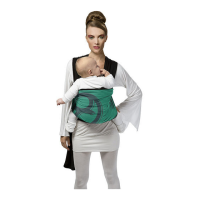11
12
2. KÄNGURU POSITION (FÜ R NEUGEBORENE BIS CA. 3 M)
Die natü rliche Position der Beinchen bei einem neugeborenen Baby ist
angewinkelt. Die Känguru Position ist im Sitzen anzulegen, damit Sie Ihr Kind
jederzeit sichern können.
1. Folgen Sie den Grundschritten A-C , so dass die Bänder gerade und
ungekreuzt von den Schultern hängen.
2. Formen Sie einen Tuchbeutel aus dem Bauchband.
3. Nehmen Sie das Baby hoch und lassen Sie es von oben in den Beutel
gleiten – stü tzen Sie das Kind dabei immer am Po.
4. Ziehen Sie das Bauchband ü ber den kompletten Rü cken des Kindes, um
Wirbelsäule und Genick des Kindes Halt zu geben.
5-6. Legen Sie die beiden Brustbänder aufgebreitet und gekreuzt ü ber das
Kind.
7. Bringen Sie die beiden Enden nach hinten und kreuzen Sie diese hinter
dem Rü cken.
8. Bringen Sie die Tuchenden wieder nach vorne und verknoten Sie diese
gut vor dem Bauch.
Achtung: Halten Sie Ihr Kind während der Anlegens immer fest, da bei dieser
Position das Kind schon im Tuch sitzt noch bevor der erste Knoten gemacht
wird.
HERAUSNEHMEN DES KINDES:
Öffnen Sie die Kreuzbänder ein wenig, um das Kind aus dem Tuchbeutel zu
nehmen. Halten Sie das Kind zu jeder Zeit fest.
2. POSITION KANGOUROU (POUR LES NOUVEAU-NÉS JUSQU'À 3 MOIS)
La position „grenouille“ est la plus naturelle pour un nouveau-né. Préparez
cette position en étant assis(e) afi n que le bébé soit toujours en sécurité.
1. Suivez les étapes du nœud de base de A à C jusqu'à ce que les pans
tombent de vos épaules sans se croiser.
2. Formez une poche sur la bande centrale devant votre ventre.
3. Prenez votre bébé et, tout en soutenant ses fesses, laissez-le glisser
doucement dans la poche.
4. Tirez la bande ventrale sur toute la surface du dos de votre bébé pour
bien soutenir son cou et sa colonne vertébrale.
5-6. Croisez les deux pans à plat sur l'enfant.
7. Ramenez les deux pans dans votre dos et croisez-les.
8. Ramenez à nouveau les pans devant votre nombril et faites un noeud.
Attention: Tenez-bien votre enfant tout le temps où vous nouez l‘écharpe, car
il y est déjà assis avant que le premier nœud ne soit fait.
SORTIR L'ENFANT DE L'ÉCHARPE:
Ouvrez légèrement la bande croisée pour sortir l'enfant de sa position
kangourou. Tenez-bien l'enfant pendant toute la manœuvre.
2. KANGAROO POSITION (FOR NEWBORNS UP TO 3 M)
The natural position of a newborn’s legs is squatted.
Practise this position sitting down, so your child is secure at all times.
1. Follow the basic steps A-C until both lengths hang straight and uncrossed
from your shoulders.
2. Form a pouch out of your belly band.
3. Pick up the child and let it gently glide into the pouch – always supporting
the child’s bottom.
4. Pull the belly band over the entire back of the child in order to support to
the neck and vertebrae.
5-6. Cross both breast bands unfolded over the child.
7. Bring both ends to the back and cross them behind the back.
8. Bring both ends to the front again and tie a knot in front of your belly.
Attention: Hold on to your child at all times while tying the sling, as in this
position the child already sits in the sling even before the fi rst knot is made.
TAKING OUT THE CHILD:
Open the cross band slightly to take the child out of the kangaroo position.
Hold on to the child at all times.
123
456
78

